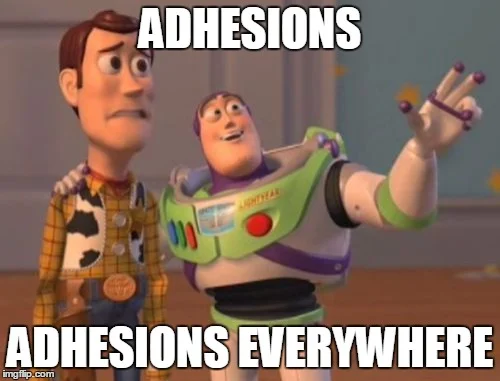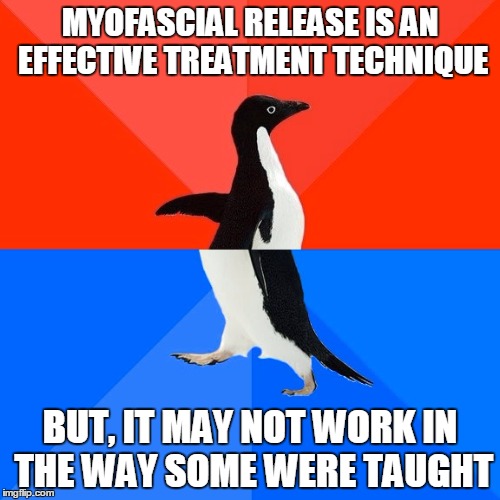Does Fascia Release?
/Evidence Based Resources
The RMT Education Project provides resources to simplify the complex -taking a intensive processes and break it down in to manageable chunks. Currently, The RMT Education Project features posts about:
The Research Countdown
• 10 Articles All Massage Therapists Should Read
• 9 Open Access Articles All Massage Therapists Should Read
• 8 Researchers Who Are Changing Massage Therapy
Open Access Tools & Resources
• Curated Resources for Massage Therapists
• Open Access Research Papers
• Resources for Patients
Research Review
• A New Muscle: The Tensor Vastus Intermedius
• Pleasure Receptors Response to Massage
• Does Fascia Release
A Brief Overview of Myofascial Release
Shout out to Jamie Johnston at The Massage Therapist Development Centre for hosting my post Myofascial Release for Massage Therapists. It had been well received and it had been requested that I make a 'cliffs notes' version, so here it is. If you liked this article, I encourage you to share it among your friends and colleagues.
There is evidence that myofascial release is an effective technique for a number of injuries. However, when it comes to anything fascia related the professional community is divided. For most massage therapist scientific literature can be hard to access and time consuming to stay current with so, with some of the research and reading I've done, I wanted to dispel myths and simplify research.
Fascial Anatomy For Massage Therapists
Anatomy textbooks often leave out fascial structures in order to depict muscles in a cleaner fashion. Recently a couple of anatomy textbooks have made an effort to include fascial structures in their depictions. An example of this is The Functional Atlas of the Human Fascial System by Carla Stecco. Another example is Anatomy Trains by Thomas Myers, in this book Myers presents conceptual ‘myofascial meridians’, a recent systematic review confirmed Superficial Back Line, The Front Functional Line and Back Functional Line as continuous soft tissue structures. Another article recently supports the notion of a functional continuity between soft tissue structures of the lower lateral line.
What is Fascia?
To better understand myofascial release, there is a need to clarify the definition of fascia and how it interacts with various other structures: muscles, nerves, vessels. Fascia is defined in many different ways, one of the most commonly accepted definition is - "Fascia is fibrous collagenous tissue which are part of a body wide tensional force transmission system" -Robert Schleip in 2012. The primary structures of the fascia are dense connective tissue (collagen fibers type I and III) and loose connective tissue (adipose cells, GAGs (glycosaminoglycans), and HA (Hyaluronan).
"Fascia is fibrous collagenous tissue which are part of a body wide tensional force transmission system"
What does Myofascial Release do?
Myofascial release results in an increased pliability of soft tissue structures that translates clinically into improved proprioception, increased range of motion, improved motor control and decreased experience of pain. For this post I have divided the response to myofascial release into three categories:
Contextual Responses to Myofascial Release- The way we present ourselves and present our techniques has influence on the treatment. The magnitude of a response may be influenced by mood, expectation, and conditioning.
Neurological Responses to Myofascial Release- Fascia is highly innervated by mechanoreceptors, this was document by Robert Schleip in 2003. His article Fascial plasticity – a new neurobiological explanation is an interesting and very readable two-part (Part 1 & Part 2) article laying out a possible neurological explanation for the beneficial effects of myofascial release. In short, manual therapy stimulates fascial mechanoreceptors, which may, in turn, trigger tonus changes in connected skeletal muscle fibers. These muscle tonus changes might then be felt by the therapist.
Mechanical Responses to Myofascial Release- The literature of Robert Schleip, Carla Stecco, Antonio Stecco and Thomas Findley support the idea that along with the neurological response and contextual response massage therapy has a mechanical effect on the fascial system. A summary of the proposed mechanisms includes but is not limited to:
- Nitric oxide release
- Altered hyaluronic acid production
- Changes in the extracellular matrix
- Fibroblast response to shear force
“Fascia and the autonomic nervous system appear to be intimately connected. A change in attitude in myofascial practitioners from a mechanical perspective toward an inclusion of the self-regulatory dynamics of the nervous system is suggested.”
Are Massage Therapists Breaking Adhesions?
I would be remiss if I did not address the notion of breaking down adhesions. An adhesion is an attachment of tissue at unusual non-anatomic sites which can be, vascular or avascular, innervated or not innervated.There is little to no research to support the claim that manual therapy can break mature adhesions. Adhesions in their developmental phase is a different story, there is research that demonstrated that manual therapy has the ability to break down immature post-surgical adhesions. If you are a massage therapist interested in the latest evidence based information on scar tissues and adhesions I recommend checking out Susan Chapelle- Understanding and Approach to Treatment of Scars and Adhesions.
“An adhesion is an attachment of tissue at unusual non-anatomic sites which can be, vascular or avascular, innervated or not innervated.”
A Reduced Ability To Glide
Traditionally when soft tissue structures have a reduced ability to glide, adhesions are blamed. An alternative possible mechanism that may explain this palpable induration is a fascial densification. Densification refers to an alteration of the loose connective tissue that may adversely affect the sliding motion of fascial layers. It is postulated that this reduced ability to glide may effect the microvascularization of neural tissue, which may result in pain and inflammation.
“Densification may affect the sliding and gliding of tissue. The different layers of the body contain viscous loose connective tissues that allow a gliding, sliding function, protecting sensitive neural structures, as well as facilitating pain-free, efficient movement and force transmission. Gliding function may be lost because of trauma, inflammation or aging, resulting in fibrosis, thickening, densification.”
To A Massage Therapist, What Does This Mean?
Myofascial release is an effective treatment technique, the catch is that it may not work in the way some were taught. This knowledge may not necessarily change the way that you apply the technique, but it may change the way communicate with therapists and patients. The name myofascial release better used as an analogous term to describe a palpable change in tissue texture that is likely due to many overlapping responses that include:
- Contextual Responses
- Neurological Responses
- Mechanical Responses
Links for The Curious
For More Article and Links Check Out The Curated Content Page
Does Fascia Release? https://t.co/5srApXRosR #myofascialrelease #fascia #massagetherapy
— Richard Lebert (@adaptivetherapy) December 14, 2015





